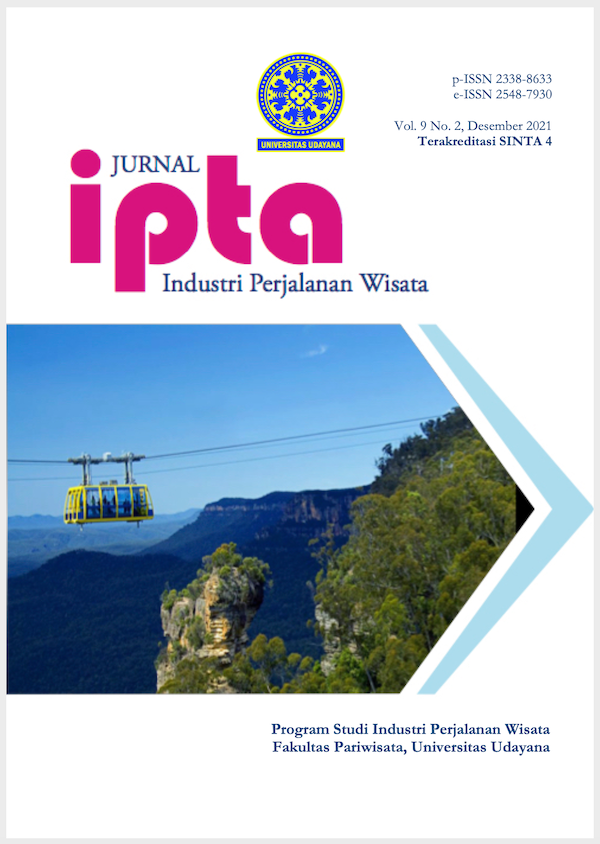EFEKTIVITAS KOMUNIKASI PEMASARAN VIRTUAL TOUR DI MUSEUM KONPERENSI ASIA-AFRIKA KOTA BANDUNG
Abstract
Virtual tours are a form of online communication marketing born in the era of the industrial revolution 4.0 due to the use of the internet of things as the backbone of movement and connectivity between humans and machines. This study aims to analyze the effectiveness of online communication marketing through a virtual tour on the Museum of the Asian-African Conference's website. The operational definition of the variables used was the AIDA variable consists of attention, interest, desire, and action with 14 total indicators. Data collection techniques used were observation, questionnaires, interviews, and literature studies. The researcher used the quota sampling technique by determining the number of samples taken was 100 respondents. The data analysis technique used was a quantitative descriptive analysis using the Customer Response Index (CRI) calculation. The results of this study indicate that the effectiveness of online communication marketing through a virtual tour on the website of the Museum of the Asian-African Conference has an average AIDA score of 3.28, which is on a scale range of 3.25 - 4.0 in a very effective way and has a CRI value of 50.7% of the overall measurement of respondents which means effective.
Downloads
References
Aprilyani, Jane. 2017. Arif Yahya Ingatkan Pentingnya Digital Tourism. (https://lifestyle.kontan.co.id/news/arief-yahya-ingatkan-pentingnya-digital-tourism diakses pada 22 Mei 2020 pukul 23.41 WITA).
Aufa, Jazaul. 2014. Efektivitas Website Sebagai Media Komunikasi Pemasaran Kampoeng Wisata Bisnis Tegalwaru, Ciampea, Bogor, Jawa Barat. Skripsi. Bogor: Institut Pertanian Bogor.
Cattaneo, Alessandro et al. 2009. The Smashing Book. Lübeck: Smashing Media.
Fennel, D.A. 1999. Ecotourism Policy and Planning. London: CABI Publishing.
Fidyah, Nurul. 2017. Efektivitas Iklan Produk Kosmetik Wardah Melalui Media Sosial Instagram (Studi pada follower @wardahbeauty pada media sosial instagram). Skripsi. Yogyakarta: Universitas Pembangunan Nasional Veteran Yogyakarta.
Ghozali, Imam. 2005. Aplikasi Analisis Multivariate dengan Program SPSS. Semarang: Badan Penerbit Universitas Diponegoro.
Guerra, José Paulo et al. 2015. Virtual Reality-Shows A New Vision for Tourism and Heritage. Covilhã: European Scientific Journal.
Jamil, Muhammad. 2018. Pemanfaatan Teknologi Virtual Reality (VR) di Perpustakaan. Buletin Perpustakaan Universitas Islam Indonesia Vol.1 No.1 Hal. 99-113.
Jyh, Ming Lien dkk. 1999. Automatically Generating Virtual Guide Tours. Geneva: IEEE, 99-106.
Kamilah, E. N. 2015. Pengaruh Keterampilan Mengajar Guru Terhadap Hasil Belajar Siswa Pada Mata Pelajaran Akuntansi. Skripsi. Bandung: Universitas Pendidikan Indonesia.
Katz, James E. and Daniel Halpern. 2015. Can Virtual Museums Motivate Students? Toward a Constructivist Learning Approach. Journal of Science Education and Technology 24:776-788. DOI 10.1007/s1095-015-9563-7.
Kotler, Philip dan Kevin Lane Keller. 2009. Manajemen Pemasaran. Jilid I. Edisi ke 13. Jakarta: Erlangga.
Kuswandi, Agus. 2017. Meningkatkan Niat Berkunjung Wisatawan di Museum Konperensi Asia Afrika Melalui Museum Virtual: Survei terhadap Wisatawan Nusantara ke Museum Konperensi Asia Afrika yang Pernah Berkunjung ke Museum Virtual Konperensi Asia Afrika. Skripsi. Bandung: Repository UPI Edu.
Pitana, I Gede dan Putu Gede Gayatri. 2005. Sosiologi Pariwisata. Yogyakarta: Andi.
Shwab, K. 2016. The Fourth Industrial Revoltion. New York: Crown Business.
Sudana, I Putu. 2013. Strategi Pengembangan Desa Wisata Ekologis di Desa Belimbing, Kecamatan Pupuan, Kabupaten Tabanan. Analisis Pariwisata Vol. 13 No.1, Hal.11.
Sugiyono, 2016. Metode Penelitian Kuantitatif Kualitatif dan R&D. 23rd ed. Bandung: Alfabeta.
Sugiyono. 2011. Metode Penelitian Kuantitatif, Kualitatif dan R&D. Bandung: Afabeta.
Umafagur, Fadli et al. 2016. Implementasi Virtual Tour sebagai Media Informasi Daerah (Studi Kasus: Kota Manado). E-Journal Teknik Informatika, Volume 9, No. 1.
Wulandari, Astri dan Nur Latifah Lutfiyati. 2018. Efektivitas Pengguna Akun Instagram @Larissacenter Sebagai Media Beriklan Larissa Aesthetic Center Berdasarkan Metode Customer Response Index (CRI). Channel Jurnal Komunikasi Vol.6 No.2 pp. 177-182.

This work is licensed under a Creative Commons Attribution-ShareAlike 4.0 International License.





